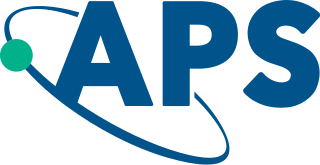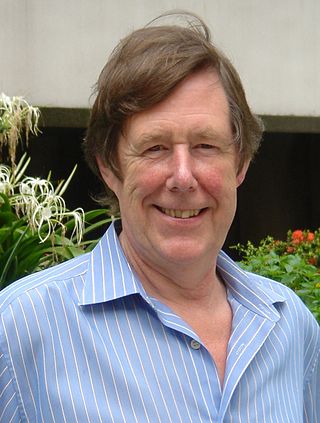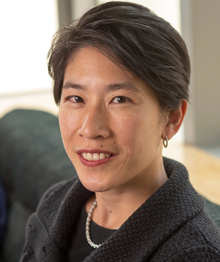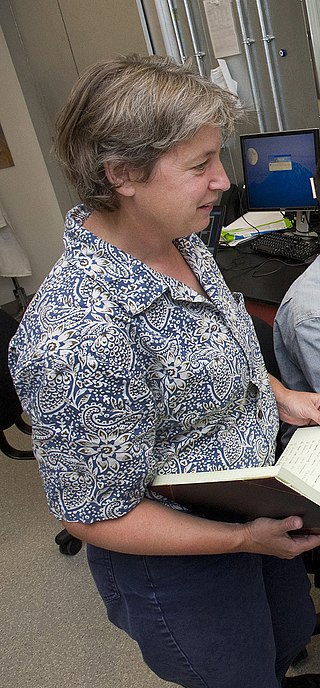Related Research Articles

The American Physical Society (APS) is a not-for-profit membership organization of professionals in physics and related disciplines, comprising nearly fifty divisions, sections, and other units. Its mission is the advancement and diffusion of knowledge of physics. It publishes more than a dozen scientific journals, including the prestigious Physical Review and Physical Review Letters, and organizes more than twenty science meetings each year. It is a member society of the American Institute of Physics. Since January 2021, it is led by chief executive officer Jonathan Bagger.

Armand Paul Alivisatos is a Greek-American chemist and academic administrator who has served as the 14th president of the University of Chicago since September 2021. He is a pioneer in nanomaterials development and an authority on the fabrication of nanocrystals and their use in biomedical and renewable energy applications. He was ranked fifth among the world's top 100 chemists for the period 2000–2010 in the list released by Thomson Reuters.

George David William Smith FRS, FIMMM, FInstP, FRSC, CEng is a materials scientist with special interest in the study of the microstructure, composition and properties of engineering materials at the atomic level. He invented, together with Alfred Cerezo and Terry Godfrey, the Atom-Probe Tomograph in 1988.
Watt Wetmore Webb was an American biophysicist, known for his co-invention of multiphoton microscopy in 1990.

Colin James Richard Sheppard, usually cited as C. J. R. Sheppard, is senior scientist at the Italian Institute of Technology in Genoa, Italy. His areas of research are in optics, microscopy and imaging, including confocal and multiphoton microscopy, diffraction, 3D imaging and reconstruction, superresolution, beam propagation, and pulse propagation.

Martin Gruebele is a German-born American physical chemist and biophysicist who is currently emeritus James R. Eiszner Chair in Chemistry, Professor of Physics, Professor of Biophysics and Computational Biology at the University of Illinois Urbana-Champaign.

Teri W. Odom is an American chemist and materials scientist. She is the chair of the chemistry department, the Joan Husting Madden and William H. Madden, Jr. Professor of Chemistry, and a professor of materials science and engineering at Northwestern University. She is affiliated with the university's International Institute for Nanotechnology, Chemistry of Life Processes Institute, Northwestern Initiative for Manufacturing Science and Innovation, Interdisciplinary Biological Sciences Graduate Program, and department of applied physics.

Jun Ye is a Chinese-American physicist at JILA, National Institute of Standards and Technology, and the University of Colorado Boulder, working primarily in the field of atomic, molecular, and optical physics.

Sergei V. Kalinin is the Weston Fulton Professor at the Department of Materials Science and Engineering at the University of Tennessee-Knoxville.

Din Ping Tsai is a physicist known for his work in the fields of photonics. He is currently a Distinguished Professor at the National Taiwan University and Director of the Research Center for Applied Sciences, Academia Sinica. He has been President of Taiwan Information Storage Association (TISA) since 2015.
James DeYoreo is the Battelle Fellow and Initiative Lead for the Materials Synthesis and Simulation Across Scales Initiative at the Pacific Northwest National Laboratory in Richland, Washington. Concurrent with his position at PNNL, he is a member of the graduate faculty, materials science and engineering, University of Washington.
Gabor Forgacs is a Hungarian theoretical physicist turned bioengineer turned innovator and entrepreneur. He was educated in Hungary, where he earned a MS and a PhD in theoretical physics at the Lorand Eotvos University in Budapest, respectively, in 1972 and in 1976. He started his scientific career at the Central Research Institute for Physics in Budapest in condensed matter physics under the supervision of Alfred Zawadowsky. In 1978 he became the Candidate of Physical Sciences title awarded by the Hungarian National Academy. in 1978 he joined Dr. Harry Frisch at the State University of New York in Albany as a Postdoctoral Fellow and in 1979 moved to the University of Illinois at Urbana-Champaign as a Postdoctoral Fellow in the group of Professor Michael Wortis. In 1981 he returned to the Central Research Institute for Physics in Budapest. In 1984-1986 he worked in the Theoretical Physics Laboratory at the Commissariat d'Energie Atomique (CEA) Saclay France. In 1988 he returned to the USA as Professor of Physics at Clarkson University, Potsdam NY. By 1992 he completed his studies in Biology, in particular the Embryology course at the Marine Biology Lab in Woods Hole and started contributing to the establishment of the new discipline of Biological Physics. In the same year he became the Doctor of Physical Sciences of the Hungarian Academy of Sciences. In 1999 he was named the George H. Vineyard Chair Professor of Biological Physics at the University of Missouri, Columbia (UMC), where he established a Biological Physics Group at the Department of Physics and Astronomy. It is during his years at UMC that he started his entrepreneurial activity, when he started Organovo in 2007, the first company in the space of bioprinting. In 2010 he returned to Clarkson University as the Czanderna-Storky Chair Professor of Physics and the Executive Director of the Shipley Center for Innovation. In 2011 he co-founded the company Modern Meadow that focuses on biofabricated biomaterials and served as its Chief Scientific Officer until 2016. In 2018 he co-founded the company Fork & Goode to produce cell-based meat and at present serves as its Chief Scientific Officer.
Joseph Anthony Zasadzinski, also known as "Joe Z", is an American chemical engineer from the University of California, Santa Barbara. He was awarded the status of Fellow in the American Physical Society, after he was nominated by his Division of Biological Physics in 2008, for "applying physical principles of self-assembly, directed assembly and bio-mimicry to create well-controlled lipid structures such as unilamellar vesicles and "vesosomes" for biomedical applications such as targeted drug-delivery vehicles and treatments for respiratory diseases, and for developing new microscopies." Zasadzinski currently works in the department of chemical engineering and materials science at the University of Minnesota, Twin Cities.
Franco Cacialli is an Italian physicist affiliated with the University College London. He was awarded the status of Fellow in the American Physical Society, after he was nominated by the Division of Materials Physics in 2009, for "his significant contributions to the science and technology of organic semiconductors and related applications, and especially for seminal contributions to the scanning near-field optical microscopy (SNOM) assisted lithography of organic semiconductor nanostructures.
Nadya Mason is the dean of the Pritzker School of Molecular Engineering at the University of Chicago, since October 2023. Prior to joining the University of Chicago, she was the Rosalyn Sussman Yalow Professor of Physics at the University of Illinois at Urbana-Champaign. As a condensed matter experimentalist, she works on the quantum limits of low-dimensional systems. Mason was the Director of the Illinois Materials Research Science and Engineering Center (I-MRSEC) and, from September 2022 through September 2023, the Director of the Beckman Institute for Advanced Science and Technology. She was the first woman and woman of color to work as the director at the institute. In 2021, she was elected to the National Academy of Sciences.
Yuri Suzuki is a Professor of Applied Physics at Stanford University. She studies novel ground states and magnetic phenomena. She is a Fellow of the American Physical Society and an American Competitiveness and Innovation Fellow of the National Science Foundation.
Rae Marie Robertson-Anderson is an American biophysicist who is a Professor and Associate Provost at the University of San Diego. She works on soft matter physics and is particularly interested in the transport and molecular mechanics of biopolymer networks. Robertson-Anderson is a member of the Council on Undergraduate Research.

Frances Mary Ross is the Ellen Swallow Richards Professor in Materials Science and Engineering at Massachusetts Institute of Technology. Her work involves the use of in situ transmission electron microscopy to study nanostructure formation. In 2018 she was awarded the International Federation of Societies for Microscopy Hatsujiro Hashimoto Medal. Ross is a Fellow of the American Association for the Advancement of Science, the American Physical Society, the Microscopy Society of America and the Royal Microscopical Society,
Andrew H. Marcus is a physical chemist whose multidisciplinary research on the faculty at the University of Oregon explores macromolecular dynamics in biological environments.
Ali Yazdani is an American physicist who focuses on understanding new quantum phases of matter. He is currently the James S. McDonnell Distinguished University Professor at Princeton University and the co-director of the Princeton Quantum Initiative. Yazdani is known for his research in advancing our understanding of emergent quantum phenomena by the application and development of high-resolution quantum microscopy techniques to directly visualize highly entangled quantum states of matter.
References
1. https://sites.gatech.edu/mtcicerone/
2. https://www.aps.org/funding-recognition/winners
3. https://scholar.google.com/citations?user=ioSFE_0AAAAJ&hl=en
- ↑ "Marcus T. Cicerone". nist.gov. Retrieved April 21, 2017.
- ↑ "Fellows". aps.org. Retrieved April 21, 2017.